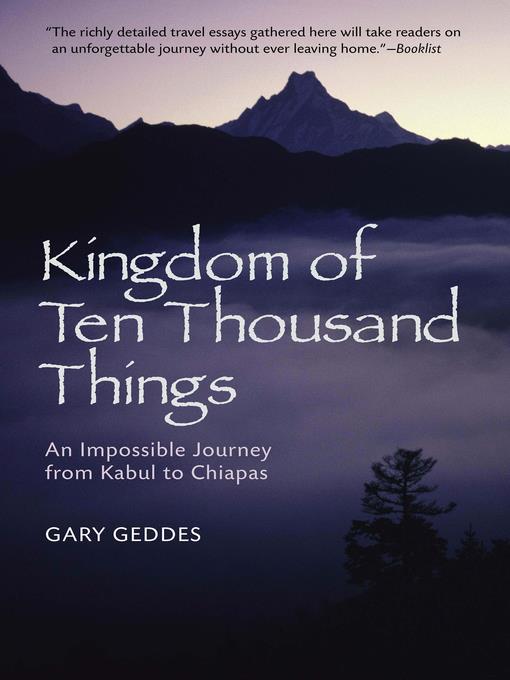
Kingdom of Ten Thousand Things
An Impossible Journey from Kabul to Chiapas
کتاب های مرتبط
- اطلاعات
- نقد و بررسی
- دیدگاه کاربران
نقد و بررسی

April 1, 2007
The routes taken by these two authors merge only briefly along the Silk Road. Geddes ("Letters for Managua") hangs his multiple journeys upon the possibility that a Buddhist monk from Afghanistan by the name of Huishen traveled to China and then across the Pacific Ocean to America in 458 C.E., before returning to China 40 years later. There is no record of the route he might have taken, which leaves Geddes to roam about central Asia visiting historical and religious sites Huishen may have seen before entering eastern China. A later journey takes Geddes to Mexico and Central America. His writing is lively and best when describing the chaotic state of affairs that have boiled over onto the surrounding region from Afghanistan. This is not an easy area in which to travel, and Geddes approaches it mostly with courage and good humor. He does not make a convincing case for, or shed any new light on, the purported travels of Huishen.
Thubron ("Lost Heart of Asia"), whose writings have established him as an expert on central Asia, here retraces some of his earlier journeys while taking many new ones. His travels took him west from Xian in China's Shaanxi Province through Kyrgyzstan and the historic cities of Samarkand and Bukhara; a brief dip into Afghanistan led to Iran before he ended up at Antakya on the Mediterranean coast of Turkey. Thubron writes of the recent imbalances in the region owing to the collapse of the Soviet Union, the westward expansion of the Chinese, and the growing restlessness of the followers of the various sects of Islam. His journey was interrupted once by fighting, and he faced additional difficulties during the SARS outbreak in the early 2000s. He travels hard but with remarkably little bragging or complaining. He understands the region well, and his writings are an important contribution to a West that hardly even knows the basic geography, let alone these cultures and sources of conflict. Geddes entertains, while Thubron both entertains and instructs. If libraries can select only one of these books, it should be Thubron's.Harold M. Otness, formerly of Southern Oregon Univ. Lib., Ashland
Copyright 2007 Library Journal, LLC Used with permission.

February 15, 2007
The distance between Kabul, Afghanistan, and Chiapas, Mexico, is 5,000 miles. Geddes undertook a journey between those two points to retrace the voyage of Huishen, a fifth-century Buddhist monk who fled from Kabul to China to escape persecution from the White Huns. Huishen then sailed from China to the Americas in AD 458 and returned in AD 499. Geddes traveled by jets, buses, taxis, pickup trucks, trains, donkeys, camels, ferries, a container ship, and several small river launches through 12 countries, and the 18-month trip took him through war zones, a desert, a jungle, mountain passes, floods, ancient ruins, and muskeg bogs. He met Pakistani dissidents, Tibetan monks, hustlers, sightseers, Afghan refugees, and Buddhist scholars, as well as many working poor people who helped him along the way. Geddes has written and edited 30 books and several literary anthologies, and the richly detailed travel essays gathered here will take readers on an unforgettable journey without ever leaving home.(Reprinted with permission of Booklist, copyright 2007, American Library Association.)

























دیدگاه کاربران